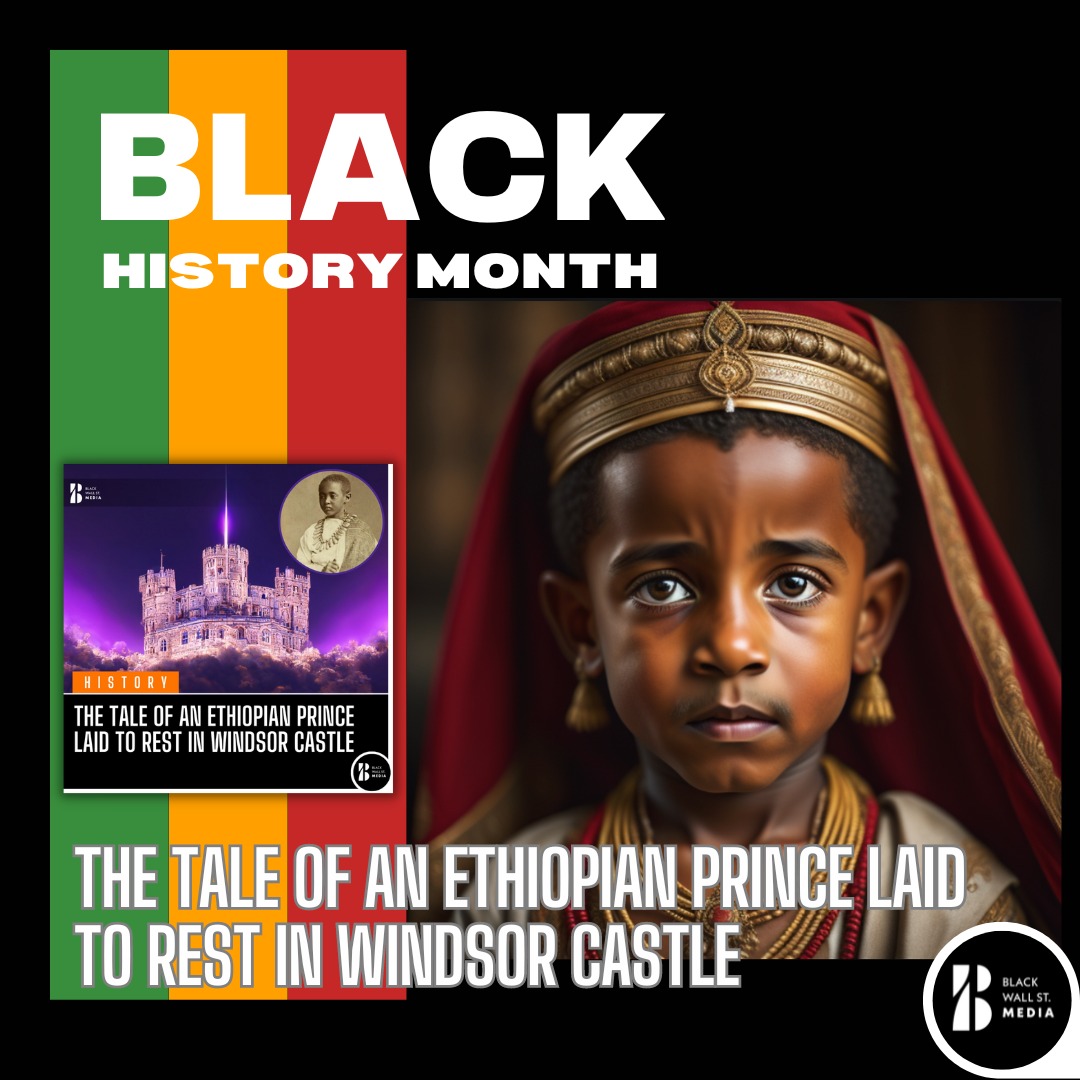HISTORY
The Tale of an Ethiopian Prince Laid to Rest in Windsor Castle
Black Wall St. MediaContributor

Windsor Castle, nestled amidst the picturesque English countryside, is a renowned symbol of British royalty and history.
With its grandeur and rich heritage, the castle houses a multitude of stories from centuries past.
One such remarkable tale is that of an Ethiopian prince who, against his will, found his final resting place within the hallowed grounds of Windsor Castle.
This article delves into the captivating account of this prince, shedding light on the circumstances that brought him to Britain and the legacy he left behind.
A Prince’s Journey:

Our story begins in the 19th century when Britain was expanding its colonial empire and exerting influence across the African continent.
At the time, Ethiopia, known as Abyssinia, was a sovereign nation ruled by Emperor Tewodros II. It was during his reign that his young son, Prince Alemayehu, embarked on a journey that would change the course of his life forever.
In 1868, British soldiers, under the command of General Robert Napier, invaded Ethiopia with the intention of securing the release of several European hostages held by Emperor Tewodros II.
Among the captives was Prince Alemayehu, then a tender age of seven. After a fierce battle, the emperor’s forces were defeated, and the British troops captured the royal family, including the young prince.
Life in Exile:

Prince Alemayehu’s capture marked the beginning of a tumultuous life in exile. Separated from his homeland, culture, and loved ones, he was taken to Britain against his will. Initially, he resided with the British troops, who treated him with relative kindness.
However, after the death of Emperor Tewodros II, the prince’s fate took an unfortunate turn.
With his father’s demise, Alemayehu became an orphan in a foreign land. The British government, uncertain about his future, decided to take him under their care.
He was placed in the custody of Captain Tristram Speedy, who became his guardian. Speedy, along with his wife, provided the prince with a home and education, intending to prepare him for a future return to Ethiopia.
A Life Cut Short:
Despite his efforts to adapt to his new surroundings, Prince Alemayehu’s heart yearned for his homeland. He dreamt of reclaiming his rightful place as the prince of Ethiopia. Unfortunately, fate had other plans. Tragically, Alemayehu’s health began to deteriorate rapidly, and at the tender age of eighteen, he succumbed to illness in 1879.
The Burial at Windsor Castle:
Following his untimely passing, the question of where to lay the prince to rest became a matter of great importance. In recognition of his royal lineage and the tragic circumstances surrounding his life, the British government decided to bury Prince Alemayehu in the Royal Burial Ground at Windsor Castle.
On May 21, 1879, the prince’s funeral procession made its way through the streets of Windsor, accompanied by soldiers, dignitaries, and mourners from various backgrounds. The funeral service, held with solemnity and dignity, took place within the castle’s walls, where Alemayehu was laid to rest in a specially built mausoleum.
Acknowledging the Past:
To embark on the path of reconciliation, acknowledging the injustices and scars of the past is paramount. The Ethiopian government has taken significant steps in acknowledging the historical wrongs committed against Prince Alemayehu and the Ethiopian people during the era of British colonialism. Recognizing the impact of these actions, the government has sought to bring attention to the prince’s story and raise awareness about the broader context of colonial oppression.
Preserving Cultural Heritage:
In its pursuit of reconciliation, the Ethiopian government recognizes the importance of preserving and celebrating its rich cultural heritage. Efforts have been made to safeguard Ethiopia’s diverse traditions, languages, and historical artifacts, ensuring their significance is acknowledged and cherished. By valuing cultural heritage, the government aims to foster a sense of pride and unity among the Ethiopian people, reaffirming their collective identity.
Promoting Education and Awareness:
Education plays a pivotal role in promoting understanding, empathy, and reconciliation. Recognizing this, Ethiopia’s government has placed a renewed emphasis on education programs that shed light on the nation’s history and the impact of colonialism. By integrating this knowledge into the curriculum, young Ethiopians are provided with a comprehensive understanding of their country’s past, enabling them to appreciate the efforts towards reconciliation and work towards a more harmonious future.
Reconnecting with the Diaspora:
Ethiopia’s journey towards reconciliation extends beyond its borders. The government has actively sought to engage with the Ethiopian diaspora, acknowledging their significance as valuable contributors to the nation’s growth and development. By fostering connections and nurturing dialogue with Ethiopians living abroad, the government aims to strengthen ties and build bridges that transcend geographical boundaries. This outreach facilitates the sharing of experiences, knowledge, and ideas, enriching the reconciliation process.
Reconciliation through Diplomacy:
Ethiopia has also taken diplomatic steps to forge reconciliation on an international scale. It has engaged in constructive dialogues with former colonizing powers, including Britain, aiming to address historical grievances and foster mutual understanding. Through these diplomatic efforts, Ethiopia seeks acknowledgment and accountability for the past, paving the way for healing and building stronger relationships based on equality and respect.
Restoration of Prince Alemayehu’s Legacy:
The burial of Prince Alemayehu in Windsor Castle serves as a powerful symbol of the historical injustices faced by Ethiopia.
In recent years, the Ethiopian government has intensified efforts to honor his legacy.
By working closely with British authorities, there have been discussions surrounding the potential repatriation of Prince Alemayehu’s remains to his homeland.
This gesture of reconciliation would provide closure and healing for the Ethiopian people, allowing them to pay their respects and reconnect with their lost prince.
Conclusion:
Ethiopia’s journey towards reconciliation demonstrates the government’s commitment to healing the wounds of the past and building a more inclusive and harmonious future.
Through acknowledging historical injustices, preserving cultural heritage, promoting education, engaging with the diaspora, and fostering diplomatic relationships, Ethiopia aims to bridge divides and cultivate a spirit of unity and understanding.
”By honoring Prince Alemayehu's legacy, Ethiopia not only seeks closure but also reaffirms its resilience and determination to forge a brighter path for generations to come.
Black Wall St. MediaContributor



















